It looks like you're using an Ad Blocker.
Please white-list or disable AboveTopSecret.com in your ad-blocking tool.
Thank you.
Some features of ATS will be disabled while you continue to use an ad-blocker.
share:
MAHLI tackles Grange
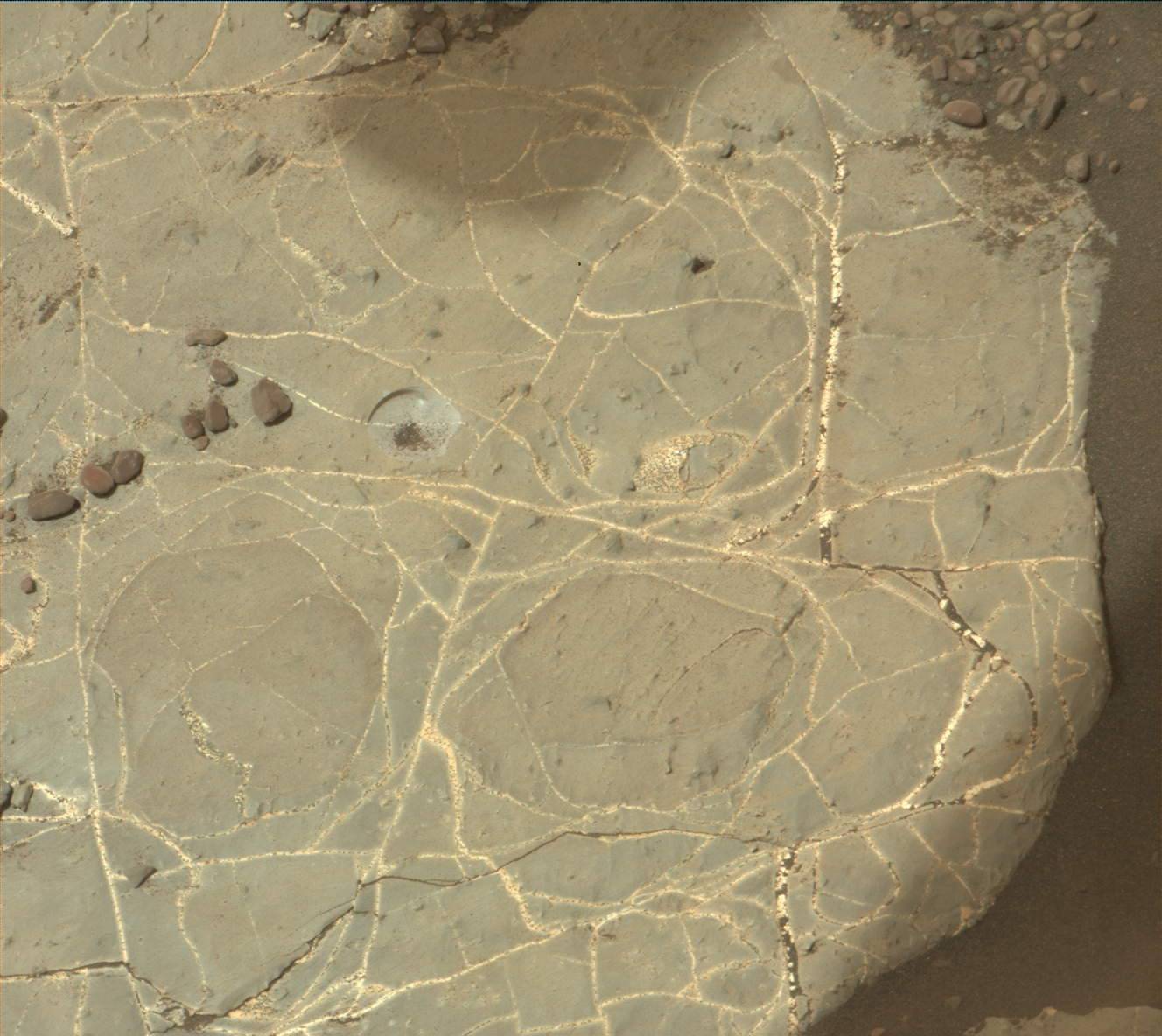 The above Mastcam image shows the attempted drill hole about center and Grange to the right of it.
The above Mastcam image shows the attempted drill hole about center and Grange to the right of it.
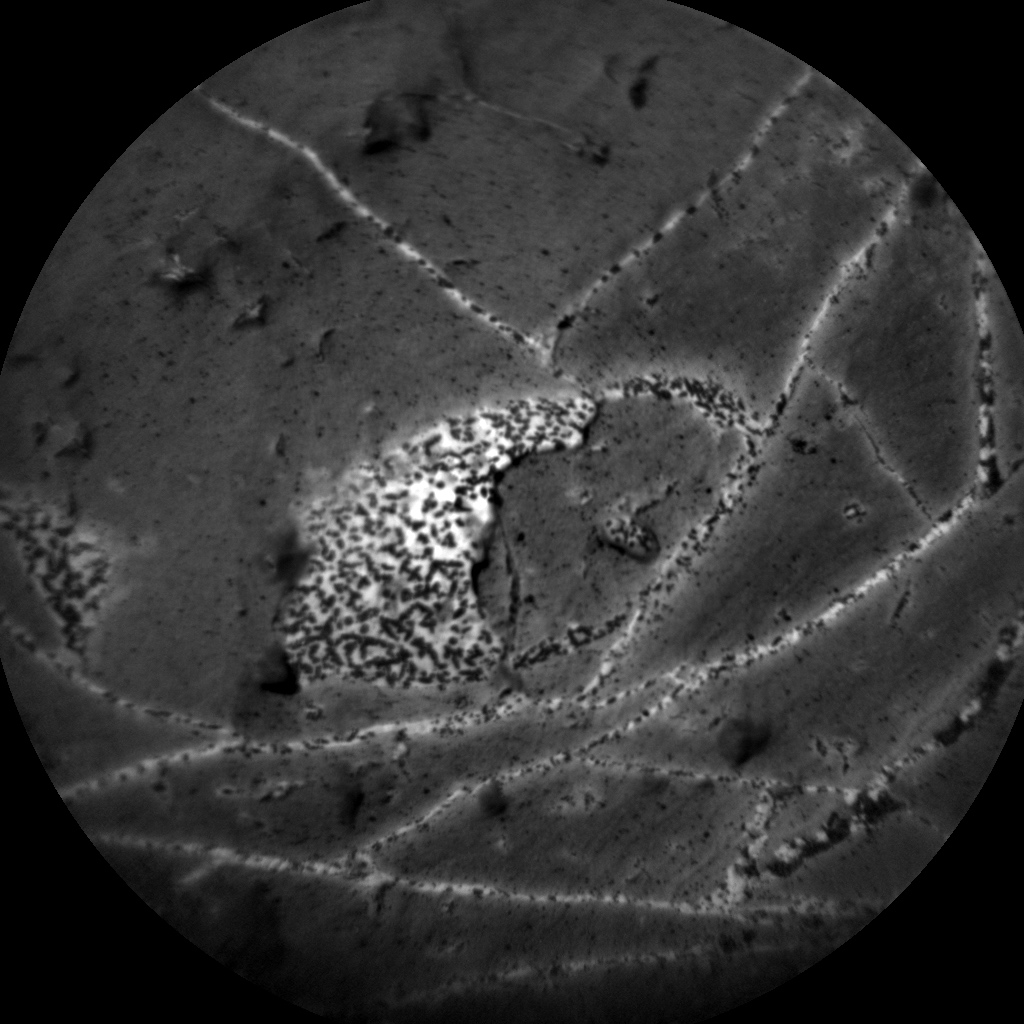 The above ChemCam image is of the target Grange.
The above ChemCam image is of the target Grange.
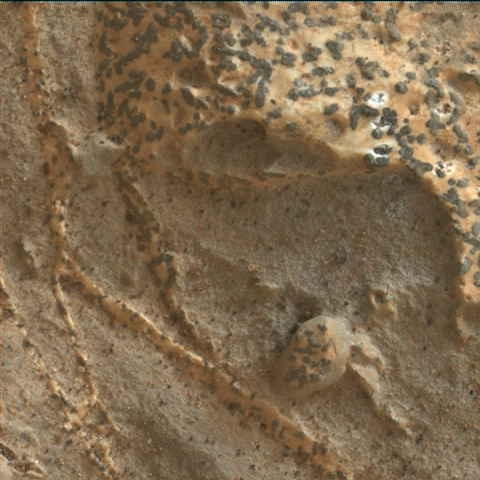
Since MSL has started sending back pictures again I decided to take a look at some of the new images coming down. I found the target 'Grange' near the attempted drill hole at Inverness to be rather interesting.
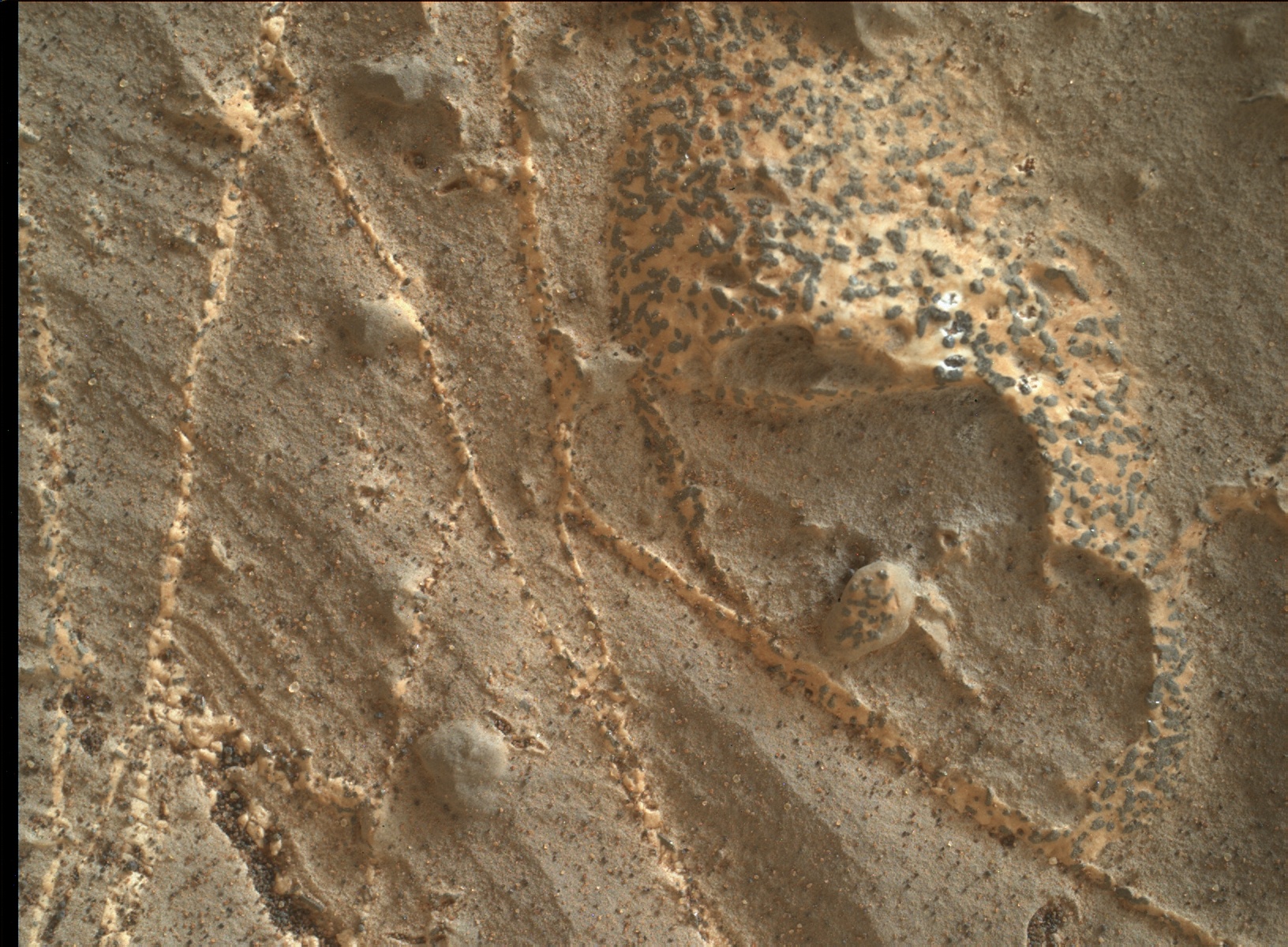
I can't remember MSL showing us anything like this before. It could be Inclusions or maybe crystals or even signs of past or present life.
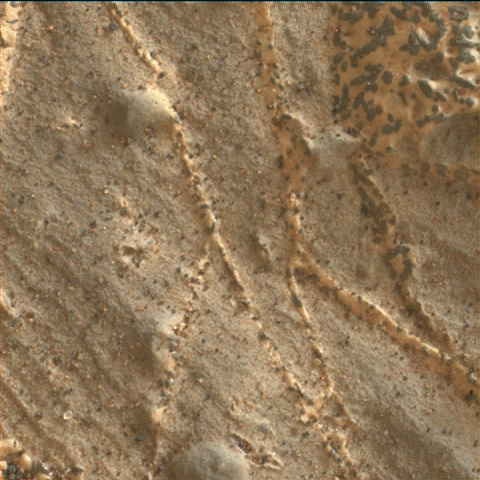
Grange seems to have the same bright calcium sulfate that has been seen in the veins in the bedrock since landing. However Grange has small dark areas that are bound to have an interesting make-up.

Just glad to see the old girl is again sending us pictures of rocks.

MAHLI tackles Grange - Sol 2217, November 1, 2018. The Mars Hand Lens Imager (MAHLI) has taken a look at Grange.


Since MSL has started sending back pictures again I decided to take a look at some of the new images coming down. I found the target 'Grange' near the attempted drill hole at Inverness to be rather interesting.

I can't remember MSL showing us anything like this before. It could be Inclusions or maybe crystals or even signs of past or present life.

Grange seems to have the same bright calcium sulfate that has been seen in the veins in the bedrock since landing. However Grange has small dark areas that are bound to have an interesting make-up.

Just glad to see the old girl is again sending us pictures of rocks.
a reply to: LookingAtMars
Based on visual analysis alone, there are a lot of things that might be signs of life.
And aren't.
It could be Inclusions or maybe crystals or even signs of past or present life.
Based on visual analysis alone, there are a lot of things that might be signs of life.
And aren't.
originally posted by: Phage
a reply to: LookingAtMars
It could be Inclusions or maybe crystals or even signs of past or present life.
Based on visual analysis alone, there are a lot of things that might be signs of life.
And aren't.
Obviously true, on the other hand they could be signs of life, who is to say. We have no boots on the ground.
a reply to: LookingAtMars
And won't, I'm afraid, for a good while. Baby steps. Space is not a friendly place for humans.
mars.nasa.gov...
We have no boots on the ground.
And won't, I'm afraid, for a good while. Baby steps. Space is not a friendly place for humans.
The mission takes the next step by not only seeking signs of habitable conditions on Mars in the ancient past, but also searching for signs of past microbial life itself.
mars.nasa.gov...
edit on 11/4/2018 by Phage because: (no reason given)
"The mission takes the next step by not only seeking signs of habitable conditions on Mars in the ancient past, but also searching for signs of past
microbial life itself."
Or the mission takes a step back by finding signs of life like Viking did.
Or the mission takes a step back by finding signs of life like Viking did.
edit on 4-11-2018 by LookingAtMars because: fix quote
a reply to: LookingAtMars
Ambiguous results are just that. No more, no less.
Some things have been learned since then.
Ambiguous results are just that. No more, no less.
Some things have been learned since then.
edit on 11/4/2018 by Phage because: (no reason given)
originally posted by: Phage
a reply to: LookingAtMars
Ambiguous results are just that. No more, no less.
Some things have been learned since then.
It is still a huge step back, no?
a reply to: LookingAtMars
No.
This mission will penetrate the surface.
No.
This mission will penetrate the surface.
edit on 11/4/2018 by Phage because: (no reason given)
a reply to: LookingAtMars
The first attempt was quite ambitious and all it produced was ambiguity.
Later landers (which can move and can do a variety of observations) are not a step back, but a means of focus (and science).
Side note: if 2020 finds no sign of life, will you protest based only on those early, ambiguous results?
The first attempt was quite ambitious and all it produced was ambiguity.
Later landers (which can move and can do a variety of observations) are not a step back, but a means of focus (and science).
Side note: if 2020 finds no sign of life, will you protest based only on those early, ambiguous results?
edit on 11/4/2018 by Phage because:
(no reason given)
Oh yeah ? What about the little white velociraptor foot prints in the bottom pic ? Hmmmmm
originally posted by: Phage
a reply to: LookingAtMars
It could be Inclusions or maybe crystals or even signs of past or present life.
Based on visual analysis alone, there are a lot of things that might be signs of life.
And aren't.
originally posted by: Phage
a reply to: LookingAtMars
The first attempt was quite ambitious and all it produced was ambiguity.
Later landers (which can move and can do a variety of observations) are not a step back, but a means of focus (and science).
Side note: if 2020 finds no sign of life, will you protest based only on those early, ambiguous results?
I think you miss my point. The fact NASA quit looking for life on Mars for so long and now will look again finally is huge. They may not find any. If there is life still on Mars I think it is most likely deep underground.
a reply to: LookingAtMars
They didn't quit. They took a step back an realized that looking for life was more complicated than they first thought. Because...ambiguity and stuff.
But it is "huge" that they think they've figured out a better way to go about it.
The fact NASA quit looking for life on Mars for so long and now will look again finally is huge.
They didn't quit. They took a step back an realized that looking for life was more complicated than they first thought. Because...ambiguity and stuff.
But it is "huge" that they think they've figured out a better way to go about it.
a reply to: Phage
No mission since Viking has had the stated goal of looking for life. It has been follow the water. And then when there is water to follow maybe, they are scared to go near it...
We agree about the better way
ETA:
Life on Mars? 40 Years Later, Viking Lander Scientist Still Says 'Yes'
No mission since Viking has had the stated goal of looking for life. It has been follow the water. And then when there is water to follow maybe, they are scared to go near it...
We agree about the better way
ETA:
ambiguity and stuff
Life on Mars? 40 Years Later, Viking Lander Scientist Still Says 'Yes'
Now, more than four decades after the Viking landings — and with a lot more information about Mars in hand — Levin believes that NASA hasn't properly followed up on the Viking landers' results.
Gilbert Levin, Mars maverick. Credit: Gilbert Levin "I am certain that NASA knows there is life on Mars," he said this past July on David Livingston's popular online program "The Space Show." Levin called for a re-examination of Viking LR data by an objective panel. But there's more. Over the past 40 years, a succession of orbiters, landers and rovers has gathered evidence that life exists on Mars today, Levin said. There is "substantial and circumstantial evidence for extant microbial life on Mars," he said on "The Space Show."
edit on 4-11-2018 by LookingAtMars because: fix
a reply to: LookingAtMars
So is this you saying this or someone in authority? Because a layman saying 'it looks like it could be...' is really just a bunch of cool pictures, which are still really cool.
So is this you saying this or someone in authority? Because a layman saying 'it looks like it could be...' is really just a bunch of cool pictures, which are still really cool.
a reply to: LookingAtMars
Could be. Or not. The white crystalline matrix and black crystals could be many things. Looks like a metamorphic rock I picked up on St. Croix in 1974. This being mars and all, the black stuff is very likely some kind of iron compound. And given Mars' watery past, the white stuff is very likely a silica compound. I wonder what the results will show ... iron oxide crystals do form in conjunction with bacteriological activity. But maybe not always...what do I know?
Regardless,
I want to believe!
It could be Inclusions or maybe crystals or even signs of past or present life.
Could be. Or not. The white crystalline matrix and black crystals could be many things. Looks like a metamorphic rock I picked up on St. Croix in 1974. This being mars and all, the black stuff is very likely some kind of iron compound. And given Mars' watery past, the white stuff is very likely a silica compound. I wonder what the results will show ... iron oxide crystals do form in conjunction with bacteriological activity. But maybe not always...what do I know?
Regardless,
I want to believe!
From the Unmanned Spaceflight Forum:
www.unmannedspaceflight.com...
I think we are seeing a calcium sulphate with some metallic oxides (maybe iron or manganese) carried by the water that was reacting with the rock.
www.unmannedspaceflight.com...
a reply to: OccamsRazor04
Just a Layman's opinion. That's why I used could be and maybe. Who knows? But looks very interesting.
Just a Layman's opinion. That's why I used could be and maybe. Who knows? But looks very interesting.
originally posted by: Namdru
a reply to: LookingAtMars
It could be Inclusions or maybe crystals or even signs of past or present life.
Could be. Or not. The white crystalline matrix and black crystals could be many things. Looks like a metamorphic rock I picked up on St. Croix in 1974. This being mars and all, the black stuff is very likely some kind of iron compound. And given Mars' watery past, the white stuff is very likely a silica compound. I wonder what the results will show ... iron oxide crystals do form in conjunction with bacteriological activity. But maybe not always...what do I know?
Regardless,
I want to believe!
I agree with you 100%
new topics
-
Are you ready for the return of Jesus Christ? Have you been cleansed by His blood?
Religion, Faith, And Theology: 1 hours ago -
Chronological time line of open source information
History: 2 hours ago -
A man of the people
Diseases and Pandemics: 3 hours ago -
Ramblings on DNA, blood, and Spirit.
Philosophy and Metaphysics: 4 hours ago -
4 plans of US elites to defeat Russia
New World Order: 5 hours ago -
Thousands Of Young Ukrainian Men Trying To Flee The Country To Avoid Conscription And The War
Other Current Events: 9 hours ago -
12 jurors selected in Trump criminal trial
US Political Madness: 11 hours ago -
Iran launches Retalliation Strike 4.18.24
World War Three: 11 hours ago
top topics
-
Israeli Missile Strikes in Iran, Explosions in Syria + Iraq
World War Three: 12 hours ago, 17 flags -
Iran launches Retalliation Strike 4.18.24
World War Three: 11 hours ago, 6 flags -
Thousands Of Young Ukrainian Men Trying To Flee The Country To Avoid Conscription And The War
Other Current Events: 9 hours ago, 6 flags -
12 jurors selected in Trump criminal trial
US Political Madness: 11 hours ago, 4 flags -
4 plans of US elites to defeat Russia
New World Order: 5 hours ago, 2 flags -
A man of the people
Diseases and Pandemics: 3 hours ago, 2 flags -
Chronological time line of open source information
History: 2 hours ago, 2 flags -
Ramblings on DNA, blood, and Spirit.
Philosophy and Metaphysics: 4 hours ago, 1 flags -
Are you ready for the return of Jesus Christ? Have you been cleansed by His blood?
Religion, Faith, And Theology: 1 hours ago, 0 flags
active topics
-
Russian intelligence officer: explosions at defense factories in the USA and Wales may be sabotage
Weaponry • 170 • : FlyersFan -
Two Serious Crimes Committed by President JOE BIDEN that are Easy to Impeach Him For.
US Political Madness • 17 • : TheSemiskepticII -
Israeli Missile Strikes in Iran, Explosions in Syria + Iraq
World War Three • 63 • : CarlLaFong -
12 jurors selected in Trump criminal trial
US Political Madness • 33 • : Myhandle -
Biden--My Uncle Was Eaten By Cannibals
US Political Madness • 49 • : iaylyan -
Thousands Of Young Ukrainian Men Trying To Flee The Country To Avoid Conscription And The War
Other Current Events • 11 • : Consvoli -
"We're All Hamas" Heard at Columbia University Protests
Social Issues and Civil Unrest • 130 • : ImagoDei -
European court rules human rights violated by climate inaction
Fragile Earth • 61 • : iaylyan -
Post A Funny (T&C Friendly) Pic Part IV: The LOL awakens!
General Chit Chat • 7124 • : underpass61 -
Are you ready for the return of Jesus Christ? Have you been cleansed by His blood?
Religion, Faith, And Theology • 5 • : Hakaiju
